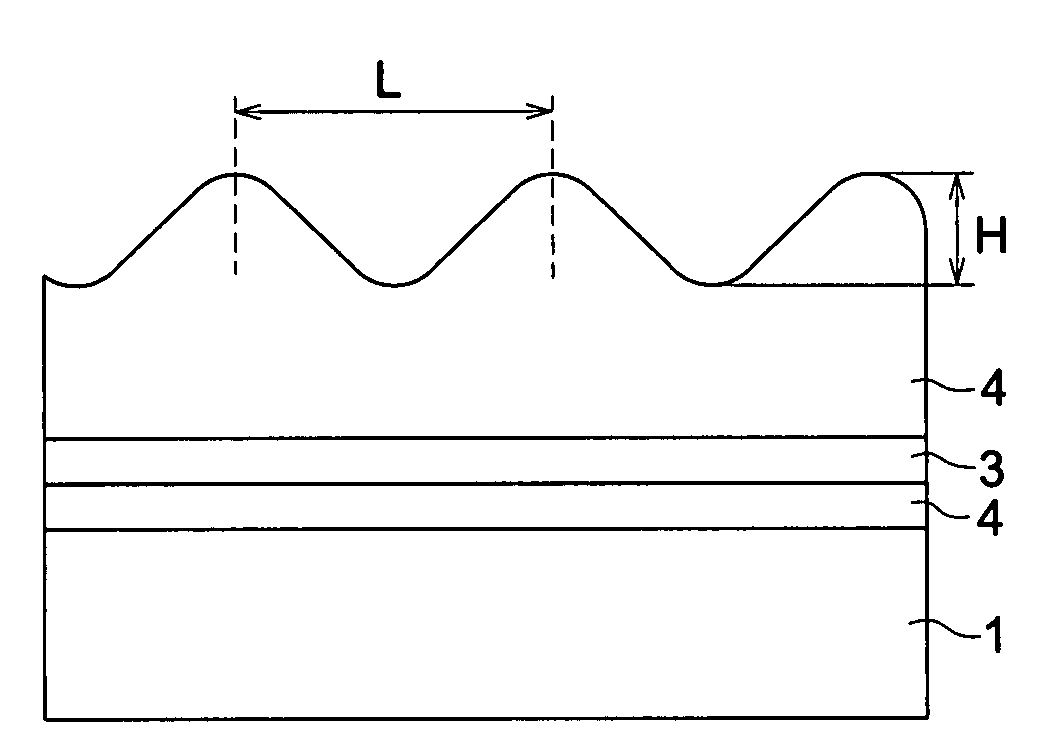Resin Film Substrate for Organic Electroluminescence and Organic Electroluminescence Device
- Summary
- Abstract
- Description
- Claims
- Application Information
AI Technical Summary
Benefits of technology
Problems solved by technology
Method used
Image
Examples
second embodiment
[0102]Next, the present invention is shown in FIG. 5.
[0103]This is an example of the resin film substrate which comprises a gas barrier layer which has a layer (diffusion layer) which diffracts or diffuses light which is also a stress relief layer on the outermost layer.
first embodiment
[0104]In the same manner as the first embodiment, the stress relief layer 4, as also an adhesive layer, is provided on a PES (thickness 200 μm) as a resin film substrate 1. That is to say, a vacuum deposition device is used and polymethyl methacrylate oligomer is introduced and deposited, and ultraviolet light is introduced in the same manner and polymerization is done to form a PMMA polymer film (thickness 200 μm). Next, in the same manner, on this film, a silicon oxide film is formed with a thickness of 200 μm by the plasma CVD method, and these are repeated and in the same manner, the PMMA layer (200 nm) which is the stress relief layer 4 as well as the gas barrier layer (silicon oxide layer) 3 which is 200 nm thick for example, is provided on the silicon oxide film.
[0105]In this embodiment, as a outermost layer, a diffusion layer (layer which diffracts or diffuses light) 5 which is also a stress relief layer is provided. Because this diffusion layer diffracts or diffuses light, ...
third embodiment
[0107]Next the present invention will be described.
[0108]In the first and second embodiment (FIGS. 3, 4 and 5), the layer having the concavo-convex structure for diffracting light provided on the outermost surface and the outermost layer (dispersion layer) which diffracts or diffuses light preferably have a refractive index which is as low as possible, and are also preferably (sufficiently) thicker (0.3 pm or more preferably 1 micron or more) than the wavelength. As a result, a portion of the light that will be totally reflected at the inside of the substrate can be taken out to the outside, and a substrate can be obtained in which the taking-out efficiency is further improved.
[0109]That is to say, the light that is totally reflected at the interface between the substrate and the outermost layer is reduced to an amount that is determined by the critical angle of the low refractive index layer. Thus the refractive index is preferably low and is preferably 1.50 or lower. The refractiv...
PUM
| Property | Measurement | Unit |
|---|---|---|
| Thickness | aaaaa | aaaaa |
| Refractive index | aaaaa | aaaaa |
Abstract
Description
Claims
Application Information
 Login to View More
Login to View More - R&D
- Intellectual Property
- Life Sciences
- Materials
- Tech Scout
- Unparalleled Data Quality
- Higher Quality Content
- 60% Fewer Hallucinations
Browse by: Latest US Patents, China's latest patents, Technical Efficacy Thesaurus, Application Domain, Technology Topic, Popular Technical Reports.
© 2025 PatSnap. All rights reserved.Legal|Privacy policy|Modern Slavery Act Transparency Statement|Sitemap|About US| Contact US: help@patsnap.com



